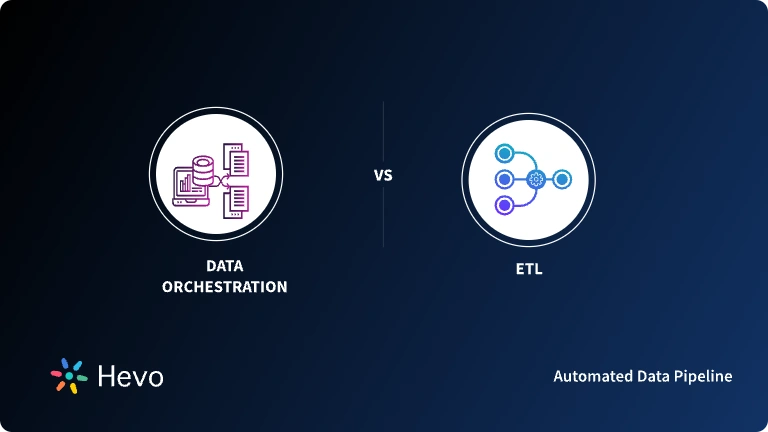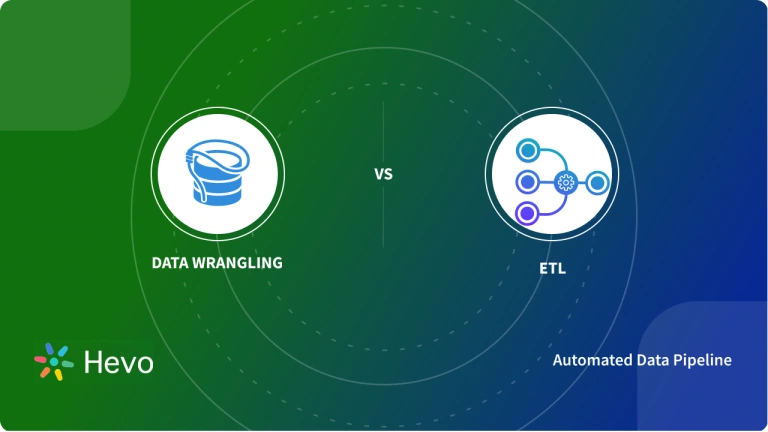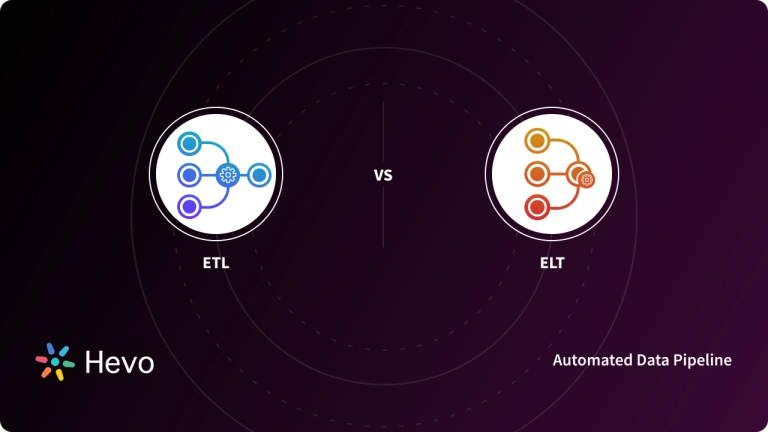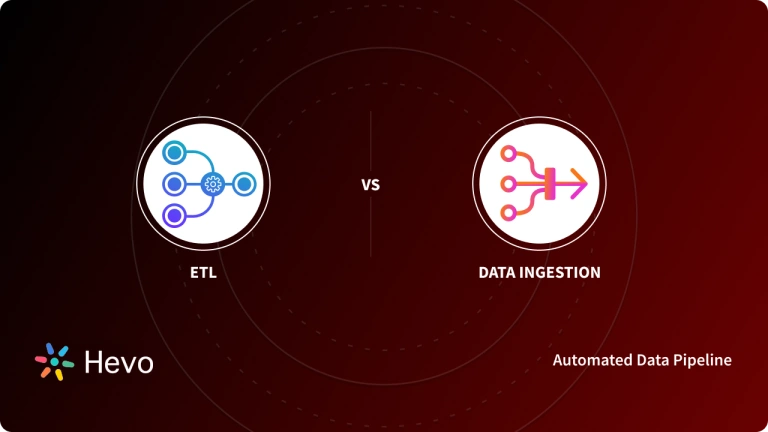The term “ETL” describes a group of processes used to extract data from one system, transform it, and load it into a target system. A more general phrase is “data pipeline,” which refers to any operation that transfers data from one system to another while potentially transforming it as well.
This blog will introduce you to the basics of both ETL and data pipelines and provide their simple applications. It will further provide you with the key difference between these 2 tools that can help you understand the ETL vs data pipeline discussion. Furthermore, it will explain the ideal use cases of both of these technologies. Read along to understand the differences between the data pipeline and ETL and choose which is best for you!
Table of Contents
What Is a Data Pipeline?

Data pipeline acts as the medium using which you can transfer data from the source system or application to the data repository of your choice. The architecture of a data pipeline is made up of software tools that collaborate to automate the data transfer process. A data pipeline can contain multiple sub-processes, including data extraction, transformation, aggregation, validation, etc. It is an umbrella term for all the data-related processes that can take place during data’s journey from source to destination.
The term “data pipeline” can refer to any combination of processes that ultimately transfer data from one location to another. This implies a data pipeline doesn’t need to transform the data during its transfer. This differentiates between a ETL vs data pipeline which is also a specific type of data pipeline. Generally, any of the subprocesses, like data replication, filtering, transformation, migrations, etc, can be present in any sequence as part of a data pipeline.
With Hevo, setting up and managing your automated ETL data pipeline is a breeze through a simple three-step process. It converts data into an analysis-ready format without requiring any coding.
Trusted by over 2000 customers, Hevo offers the following advantages:
- Real-Time Data Sync: Continuous data synchronization ensures your analytics are always current.
- User-Friendly Interface: Manage and oversee your integrations easily with a clear and intuitive interface.
- Security: Hevo adheres to essential certifications, including GDPR, SOC II, and HIPAA, ensuring your data remains secure.
What Is an ETL Pipeline?
Your organization generates and collects vast data quantities every day. Now, to gather any actionable insight from this enormous sea of data, you will need to:
- Extract and collect data spread across numerous sources that are in some way relevant to your business.
- Perform data cleaning and transformations on the extracted data to make it suitable for data analysis.
- Load the transformed datasets into your chosen repository such as a data lake or a data warehouse and build a single source of truth.
Now, these processes work in a sequence to optimize your raw data into a form that is fit for analysis. However, if you are carrying out the above processes manually, various errors can occur. Your process code may throw sudden errors, certain data values may go missing, data inconsistencies can occur, and many other similar bottlenecks are possible when working with a manual ETL approach.
Businesses rely on an ETL pipeline to automate the three-step task and securely transform their data. An ETL pipeline is made up of a group of tools that work to extract raw data from different sources, transform & aggregate the raw data and finally load it to your destination storage. A good ETL pipeline also offers you end-to-end management coupled with an error-handling mechanism.
ETL vs. Data Pipeline: Key Differences Compared
The term data pipeline and ETL pipelines are almost used synonymously among data professionals. However, the differences between the data pipeline and ETL pipeline are in terms of their usage, methodology, and importance. You can get a better understanding of the differences between the data pipeline and the ETL pipeline by comparing the following differences:
| Aspect | ETL Pipeline | Data Pipeline |
| Definition | Extracts, transforms, and loads (ETL) data into a target system. | Moves data between systems; may or may not involve transformation. |
| Purpose | Designed for structured data movement, often to a data warehouse. | Handles various data processes, including streaming, analytics, and ML. |
| Transformation | Data is always transformed before being loaded. | Transformation is optional and depends on the use case. |
| Processing Mode | Batch-oriented; runs on a scheduled basis. | Can be real-time, batch, or event-driven. |
| Use Cases | Best for structured reporting and analytics. | Used for real-time analytics, machine learning, and automation. |
| Flexibility | More rigid, with predefined steps. | More flexible, supporting different data processing needs. |
Purpose
A set of procedures known as an ETL pipeline is used to extract data from a source, transform it, and load it into the target system. A data pipeline, on the other hand, is a little larger word that includes ETL as a subset. It consists of a set of tools for processing data transfers from one system to another. However, the data may or may not be transformed.
ETL vs. Data Pipeline: Transformation Process
Data pipelines and ETL pipelines are similar in that they both involve the movement and transformation of data, but there are some key differences between them.
Data pipelines focus on the movement and transformation of data within an organization. They often involve the collection, processing, and storage of data in various systems, such as data lakes or data warehouses. Data pipelines can be used for a variety of purposes, such as data analytics, machine learning, and reporting.
ETL pipelines, on the other hand, are specifically focused on the extraction, transformation, and loading of data from one system to another. ETL pipelines are often used to move data from transactional systems, such as databases, into a data warehouse or data lake for reporting and analysis.
ETL vs. Data Pipeline: How They Run?
The working methodology of data pipelines and ETL pipelines can differ depending on the specific use case and the systems involved. However, in general, data pipelines and ETL pipelines have some key differences in their working methodology.
Data pipelines often involve a continuous flow of data, where new data is collected, processed, and stored in near real-time. This allows for more dynamic and up-to-date analysis and reporting. Data pipelines also often include data quality checks, validation, and error handling to ensure that the data is clean and accurate.
ETL pipelines, on the other hand, are typically run on a schedule, such as daily or weekly. They extract data from transactional systems, transform it to fit the structure and format of the destination system, and then load it into the destination system. ETL pipelines often include more complex transformation processes, such as data mapping, data cleaning, and data deduplication.
In summary, data pipeline are more dynamic and incremental with real-time data movement and processing while ETL pipelines are more batch-oriented, with a schedule of data extraction, transformation and loading.
ETL vs. Data Pipeline: Examples
The following examples are of use cases in ETL vs. data pipeline that a data pipeline can support but are not achievable via any ETL pipelines:
- Providing you with real-time reporting services.
- Providing you with the facility to analyze data in real-time.
- Allowing you to trigger various other systems to operate different business-related processes.
ETL pipeline finds applications in various fields depending on their subtasks of extracting, transforming, and loading data. For example, if a company requires data present in different Web Services, Customer Relationship Managers (CRMs), Social Media Platforms like Facebook, etc., it will deploy an ETL pipeline and focus on the extraction part.
Similarly, the data transformation aspect of an ETL pipeline is essential for applications that need to modify their data into a reporting-friendly format. Furthermore, data loading finds applications in tasks that require you to load vast datasets into a single repository that is accessible to every stakeholder. This implies, that an ETL pipeline can have a multitude of applications based on its various sub-processes.
Choosing The Right Pipelines for Your Customer Data
Choosing between a data pipeline or an ETL pipeline depends on your specific use case and the systems involved. Both data pipelines and ETL pipelines can be used to move and transform data, but they have different strengths and are optimized for different types of use cases.
When to Choose ETL Pipelines
ETL pipelines are ideal when you need to extract, transform, and load structured data into a centralized system, such as a data warehouse. If your primary goal is to clean, format, and store data for reporting and analysis, ETL is the better choice. It works best for batch processing and handling large volumes of transactional data from multiple sources.
When to Choose Data Pipelines
Data pipelines are more flexible and suitable for real-time or near-real-time data movement. If your use case involves streaming data, machine learning, automation, or integration between various applications, a data pipeline is the better option. Unlike ETL, data pipelines may not always require transformation, making them efficient for continuous data processing.
Final Thoughts
Both ETL and data pipelines play essential roles in data movement and transformation, but their use cases differ. ETL is ideal for structured, batch processing, while data pipelines enable real-time and complex workflows. Choosing the right approach depends on your data needs and business goals.
With Hevo, you can automate ETL processes seamlessly, ensuring efficient and reliable data integration. Sign up for a 14-day free trial and experience hassle-free data pipelines with unbeatable pricing. Streamline your data workflows with Hevo’s powerful, no-code platform and focus on insights rather than infrastructure!
FAQ on ETL vs Data Pipelines
1. What is the difference between a data pipeline and ETL?
Data Pipeline: A data pipeline is a broader term that refers to the end-to-end process of collecting, processing, and delivering data from various sources to destinations.
ETL (Extract, Transform, Load): ETL is a specific type of data pipeline that focuses on extracting data from sources, transforming it into a suitable format, and loading it into a target data warehouse or database.
2. What is the difference between API and ETL pipeline?
API (Application Programming Interface): An API allows different software applications to communicate and exchange data in real-time through defined endpoints and protocols.
ETL Pipeline (Extract, Transform, Load): An ETL pipeline is a process that extracts data from various sources, transforms it into a usable format, and loads it into a data warehouse or database.
3. How is ETL pipeline different from ELT?
ETL (Extract, Transform, Load): Data is extracted, transformed before loading into the target system, which is suitable for complex transformations before data storage.
ELT (Extract, Load, Transform): Data is extracted and loaded directly into the target system first, with transformations performed afterward, allowing for efficient use of the data warehouse’s processing power.












